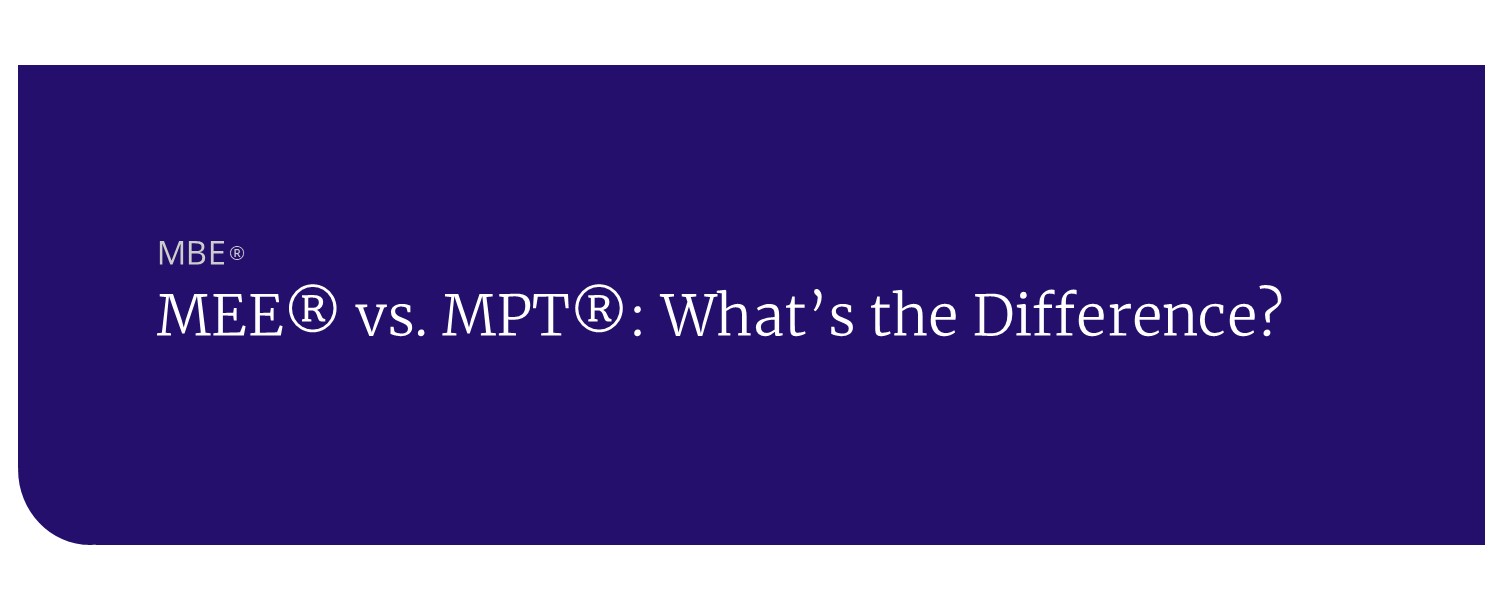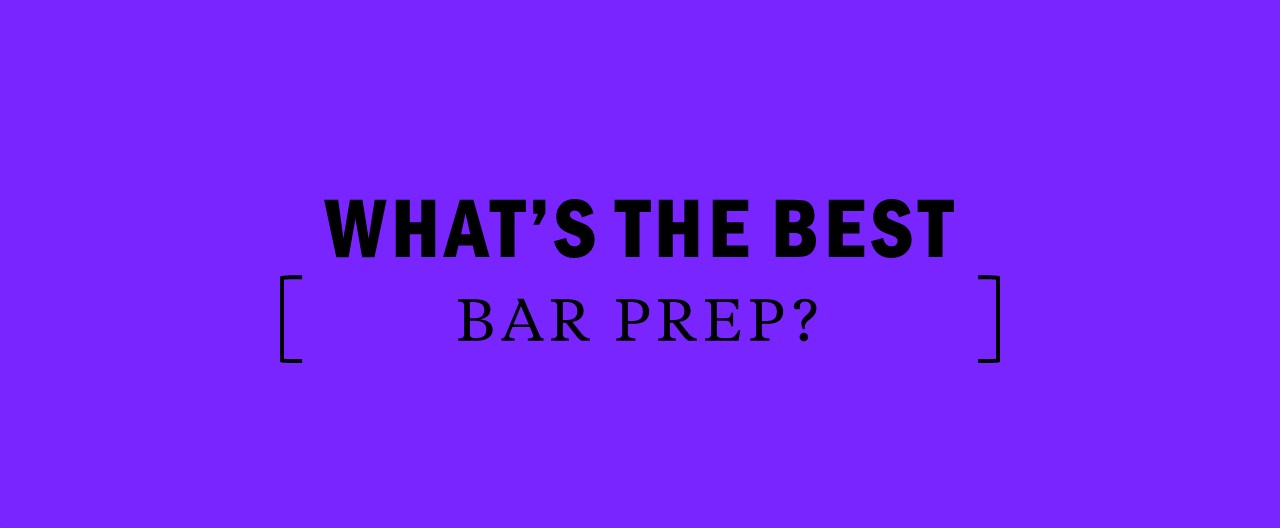MEE vs. MPT: What’s the Difference?
The Multistate Essay Examination (MEE) and Multistate Performance Test (MPT) are two written components of the Uniform Bar Exam (UBE) that test very different skills. The MEE focuses on legal analysis through timed essay questions, while the MPT measures your ability to complete practical lawyering tasks using provided materials.
Both sections play a major role in your overall UBE score, and understanding how they differ is essential for building a focused study plan. Knowing what each exam measures–and how they’re scored–can help you target your preparation, strengthen your performance, and maximize points on test day.
What is the Multistate Essay Examination (MEE)?
The MEE is a three-hour portion of the UBE made up of six essay questions, with 30 minutes allotted for each. It’s designed to measure your ability to think like a lawyer by analyzing fact patterns, applying relevant law, and communicating your reasoning clearly in writing.
Purpose of the MEE
The MEE evaluates how well you can:
- Identify and analyze legal issues
- Apply the correct legal principles to a given scenario
- Separate relevant facts from irrelevant details
- Present a well-organized, concise, and persuasive written response
Examinees are often encouraged to use the IRAC method–Issue, Rule, Application, Conclusion–to structure answers clearly and logically.
MEE Scoring
In most jurisdictions, the MEE counts for 30% of your total UBE score, though some states may weigh it slightly higher. Strong performance here can significantly boost your overall results, especially when combined with solid scores on the MBE and MPT.
What is the Multistate Performance Test (MPT)?
The MPT is a practical skills section of the UBE that simulates real-world legal tasks. It consists of two 90-minute assignments designed to evaluate how you apply lawyering skills to a factual problem using only the materials provided.
Purpose of the MPT
Unlike the MEE, the MPT does not require memorized legal knowledge. Instead, it measures your ability to:
- Review and organize case facts from a “File” of documents
- Identify relevant legal principles from a “Library” of statutes, rules, or case law
- Apply the provided law to the facts in a way that solves the client’s problem
- Communicate effectively in a format appropriate for the task, such as a memo, brief, client letter, or proposal
Structure of the MPT:
Each MPT problem contains:
- File: Source documents that lay out the facts of the case (e.g., interview transcripts, contracts, pleadings, police reports, etc.).
- Library: Legal authorities you may need, such as statutes, regulations, and case excerpts. Some information may be irrelevant, requiring you to determine what’s useful.
MPT Scoring
The MPT typically makes up 20% of your total UBE score. Because it tests skills that practicing attorneys use every day, mastering the MPT can help you balance your overall performance–especially if you’re stronger in practical application than in memorization-heavy sections like the Multistate Bar Exam (MBE).
Key Differences Between the MEE and MPT
Both the MEE and MPT contribute significantly to your UBE score, but they measure success in very different ways. The table below highlights how they differ in format, time, scoring, and the type of skills they assess.
| Feature | MEE | MPT |
| Purpose | Tests legal analysis and writing skills | Tests real-world lawyering and document drafting skills |
| Knowledge Required | Relies on memorized substantive law | All legal principles provided in exam materials |
| Format | 6 essay questions | 2 performance tasks |
| Time Allocation | 3 hours total (30 minutes per essay) | 90 minutes per task |
| Skills Emphasized | Issue spotting, applying law, IRAC structure | Organizing facts, identifying relevant law, drafting legal documents |
| Scoring Weight | ~30% of UBE score | ~20% of UBE score |
Knowing these distinctions can help you plan your study time effectively and focus on the strategies that will earn you the most points in each section.
How the MEE and MPT Work Together
Approaching the MEE and MPT as connected parts of your bar prep can make your study time more efficient. Many of the skills you develop for one section–such as organizing information, analyzing facts, and writing clearly–can be applied to the other, helping you improve your overall performance.
Here’s how the MEE and MPT complement each other:
- They Share Core Skills: Both require clear, organized legal writing under strict time limits.
- They Balance Knowledge and Application: The MEE draws on your memorized law, while the MPT focuses on applying law you’re given. Excelling in one can offset lower performance in the other.
- They Reward Efficiency: Practicing for both helps you work faster, manage exam stress, and produce high-quality answers within tight deadlines.
- They Encourage Adaptability: The MEE’s essay questions and the MPT’s practical tasks require you to switch between analytical and hands-on legal work seamlessly.
How to Prepare for the MEE and MPT
A strong bar prep strategy should include focused practice for both the MEE and MPT. Since each section has unique demands, tailoring your approach can help you maximize points and perform consistently across the written portion of the exam.
Preparation Tips for the MEE:
- Practice timed essays to build speed and maintain organization under exam conditions
- Review commonly tested subjects and focus on high-frequency topics
- Use the IRAC method to structure your answers clearly and logically
- Study sample essays and scoring guidelines to understand what graders expect
Preparation Tips for the MPT:
- Practice reviewing Files and Libraries quickly to separate relevant from irrelevant information
- Familiarize yourself with different legal document formats, such as memos, client letters, and briefs
- Work on drafting concise, well-organized responses within the 90-minute time limit
- Focus on applying the provided law accurately rather than recalling memorized rules
Get Ready to Excel on the MEE and MPT
Strong performance on the MEE and MPT comes from consistent, targeted practice and knowing exactly what each section requires. The more you work with realistic exam materials and timed exercises, the more prepared you’ll be to handle both the analytical and practical tasks on test day.
Kaplan’s Bar Review courses and exam prep give you the structure, resources, and feedback you need to sharpen your skills for every part of the UBE. From practice essays and performance tests to full-length simulated exams, you’ll have the tools to approach the written portion with skill and precision.






